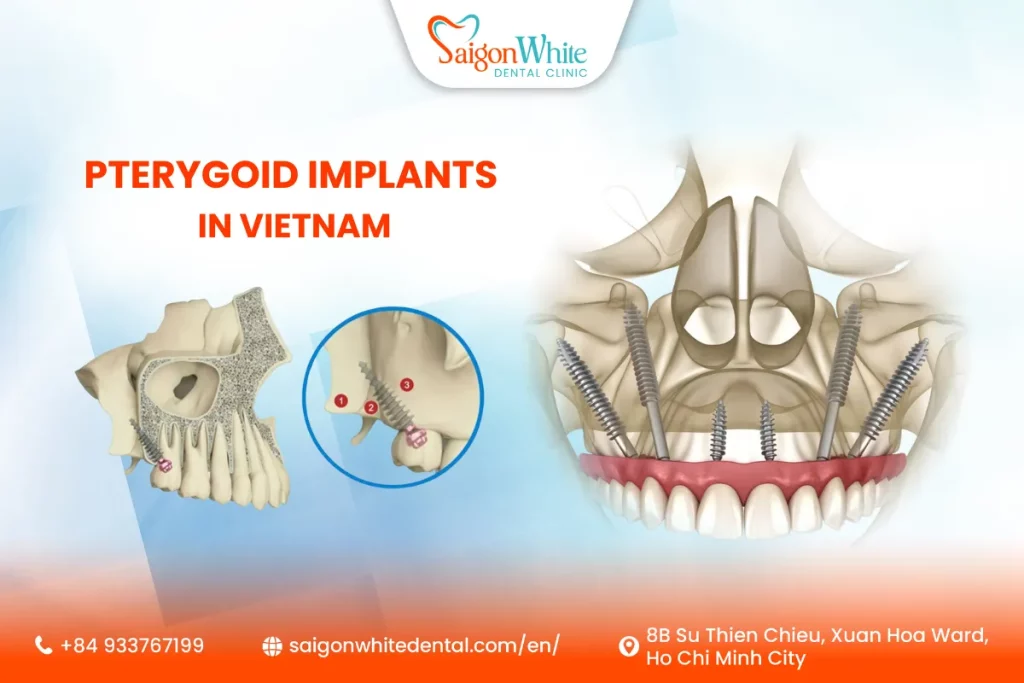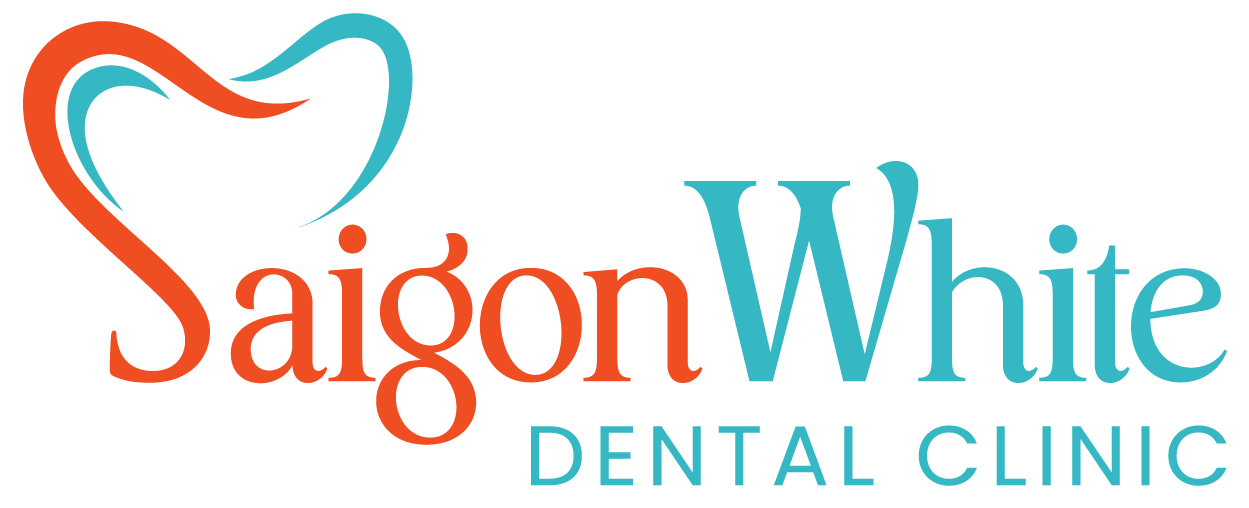Pterygoid Implants in Vietnam have emerged as a groundbreaking solution for patients with severe bone loss in the upper jaw, offering a reliable alternative when traditional implants are not feasible. Over the past two decades, Vietnam has become one of Asia’s top destinations for dental tourism, attracting patients from Australia, the United States, Europe, and neighboring Asian countries who seek advanced dental treatments at a fraction of Western costs.
Unlike conventional implants that often require bone grafting, sinus lifts, or multiple surgeries, pterygoid implants are anchored in the dense pterygoid region of the skull, providing secure and long-lasting restorations without the need for complex grafting procedures.

What Are Pterygoid Implants?
Pterygoid implants are a type of dental implant designed specifically for patients with severe maxillary bone resorption. Unlike conventional implants placed vertically into the jawbone, these implants are tilted and anchored into the pterygoid process of the sphenoid bone, located behind the upper jaw.
This unique placement offers strong anchorage, making it possible to restore missing teeth in patients who would otherwise be told they lack sufficient bone for implants.
Key characteristics include:
- Longer implants (usually 15–20 mm)
- Placement at an angle towards the back of the maxilla
- Avoidance of sinus grafting procedures
Why Choose Pterygoid Implants for Severe Bone Loss?
Severe bone loss in the upper jaw is common among long-term denture wearers or patients who lost teeth many years ago. Conventional implants often cannot be placed without grafting, but pterygoid implants offer several advantages:
- No need for sinus lifts or bone grafting – reducing cost and surgical time.
- Immediate stability – especially beneficial for full-arch restorations.
- High survival rate – comparable to traditional implants in healthy bone.
- Faster recovery – fewer procedures mean quicker treatment and healing.
For patients with advanced atrophy of the upper jaw, pterygoid implants provide an effective alternative to removable dentures.
Advantages of Pterygoid Implants in Vietnam
Choosing Vietnam for pterygoid implants comes with unique benefits:
- Cost-effectiveness: Treatment costs are up to 70% lower than in Australia, the US, or Europe.
- Advanced technology: Clinics in Ho Chi Minh City and Hanoi use CBCT scans, guided surgery, and high-quality implant systems.
- Minimally invasive approach: Less surgical trauma compared to bone grafting.
- Shorter treatment time: Full-arch solutions can often be completed within days.
- Expertise in dental tourism: Clinics are accustomed to treating international patients and often provide English-speaking staff.
Procedure of Pterygoid Implant Placement in Vietnam
The process of receiving pterygoid implants in Vietnam is systematic and patient-friendly:
- Initial consultation – CBCT imaging and 3D digital planning.
- Treatment planning – customized approach for each patient, including immediate loading options for full arches.
- Surgery day – implants placed under local anesthesia or IV sedation.
- Temporary restoration – many patients receive same-day fixed prosthetics.
- Healing period – typically 3–6 months for osseointegration.
- Final restoration – permanent crowns or bridges fitted for long-term use.
The procedure is relatively quick, and many patients can resume normal activities within a few days.
Who Is a Candidate for Pterygoid Implants?
Pterygoid implants are not for everyone, but they are specifically designed for patients who face significant challenges with bone loss in the upper jaw. Here are the main groups of candidates:
Ideal Candidates
- Patients with severe bone loss in the posterior maxilla
Those who lack sufficient bone height or width in the upper jaw may make traditional implants impossible without grafting. - Patients who want to avoid bone grafting or sinus lifts
Many people do not want to undergo multiple surgeries, long healing times, or higher costs associated with grafting. Pterygoid implants bypass these procedures. - Edentulous patients (completely missing upper teeth)
Individuals who have worn dentures for years and want a fixed, stable alternative. - Full-arch rehabilitation cases
Patients looking for “All-on-4/6” type solutions where pterygoid implants provide strong back support for bridges. - International patients seeking shorter treatment time
Dental tourists often prefer this method because it allows immediate loading and faster restoration.
Who May Not Be a Candidate
- Those with anatomical limitations that do not allow safe implant placement (rare but possible).
- Patients with uncontrolled medical conditions (e.g., severe diabetes, advanced heart disease).
- People with active gum infections or untreated periodontal disease.
- Patients with poor oral hygiene who cannot maintain long-term implant care.
Cost of Pterygoid Implants in Vietnam
The cost of pterygoid implants in Vietnam is significantly more affordable compared to Western countries:
- Vietnam: $1,200 – $1,800 per implant (depending on brand and clinic).
- Australia/US: $4,000 – $6,000 per implant.
Factors that influence pricing include:
- Implant brand (Straumann, Nobel Biocare, or local alternatives)
- Dentist’s expertise
- Clinic reputation and location
- Whether the case involves full-arch restorations
Overall, patients can expect to save 50–70% while still receiving world-class care.
Pterygoid Implants vs. Other Advanced Implant Solutions
When it comes to treating severe bone loss in the upper jaw, dentists often consider several advanced implant solutions. Each has its strengths, and the right choice depends on the patient’s condition, treatment goals, and budget. Here’s how pterygoid implants in Vietnam compare to other options:
Pterygoid Implants vs. Zygomatic Implants
- Pterygoid implants are anchored in the pterygoid process of the sphenoid bone, offering strong posterior support without grafting.
- Zygomatic implants, on the other hand, are much longer and are anchored in the cheekbone (zygoma).
- Key difference: Pterygoid implants are usually recommended for moderate to severe bone loss, while zygomatic implants are reserved for extreme cases where almost no upper jaw bone remains.
- Treatment experience: Pterygoid surgery is less invasive than zygomatic placement and often involves quicker recovery.
Pterygoid Implants vs. Bone Grafting with Conventional Implants
- Bone grafting involves rebuilding lost bone through graft material and waiting several months before implants can be placed.
- Pterygoid implants bypass grafting completely by using the natural strength of the pterygoid bone.
- Benefits: Shorter treatment time, reduced surgical complexity, and lower overall costs.
- Drawback: Requires advanced surgical skill, so choosing an experienced implantologist is essential.
Pterygoid Implants vs. Sinus Lift Procedures
- A sinus lift is a common solution when bone height is insufficient in the posterior maxilla.
- While effective, it extends treatment time and carries additional surgical risks.
- Pterygoid implants avoid the sinus area entirely, eliminating the need for sinus augmentation.
Best Dental Clinics in Vietnam for Pterygoid Implants
Vietnam’s dental tourism industry is highly developed. Patients should look for:
- Clinics with international accreditations
- Use of digital planning and 3D guided surgery
- English-speaking dentists and transparent pricing
- Positive patient reviews from international clients
Ho Chi Minh City is the hub for advanced implantology, with many reputable clinics specializing in complex implant cases.
Risks and Complications of Pterygoid Implants
Like any surgical procedure, risks exist, though complications are rare when performed by experienced implantologists:
- Sinus or nasal involvement during placement
- Temporary discomfort and swelling
- Slight risk of implant failure if not properly integrated
Vietnamese clinics with experienced surgeons report success rates above 95%, which is consistent with international standards.
Recovery and Aftercare for Pterygoid Implants
Recovery is relatively straightforward:
- First week: Soft diet and good oral hygiene.
- 1–3 months: Healing phase with temporary prosthetics.
- 3–6 months: Final restorations fitted.
Regular follow-ups and professional cleanings are crucial for long-term success.
Why International Patients Prefer Vietnam for Pterygoid Implants
Vietnam has become a hotspot for dental tourism due to:
- Affordable treatment – up to 70% cheaper than in Western countries.
- World-class standards – dentists are often trained abroad with modern equipment.
- Tourism opportunities – patients can combine dental care with exploring Vietnam’s rich culture, beaches, and cuisine.
- Excellent patient care – clinics often provide airport pick-up, hotel support, and translation services.
FAQs About Pterygoid Implants in Vietnam
Q: How long do pterygoid implants last?
A: With proper care, they can last 15–20 years or more.
Q: Is the procedure painful?
A: Most patients report minimal discomfort due to local anesthesia and sedation.
Q: Can pterygoid implants be combined with other implants?
A: Yes, they are often used together with traditional or zygomatic implants in full-arch cases.
Q: Are elderly patients eligible?
A: Yes, as long as they are medically fit for surgery.

 Telegram
Telegram